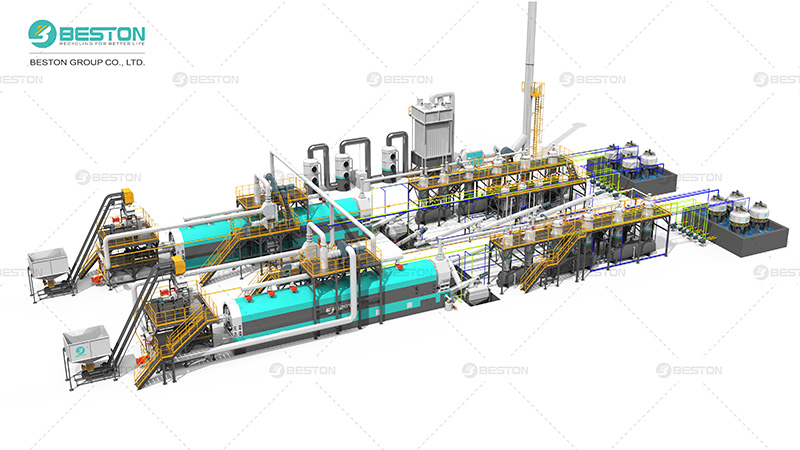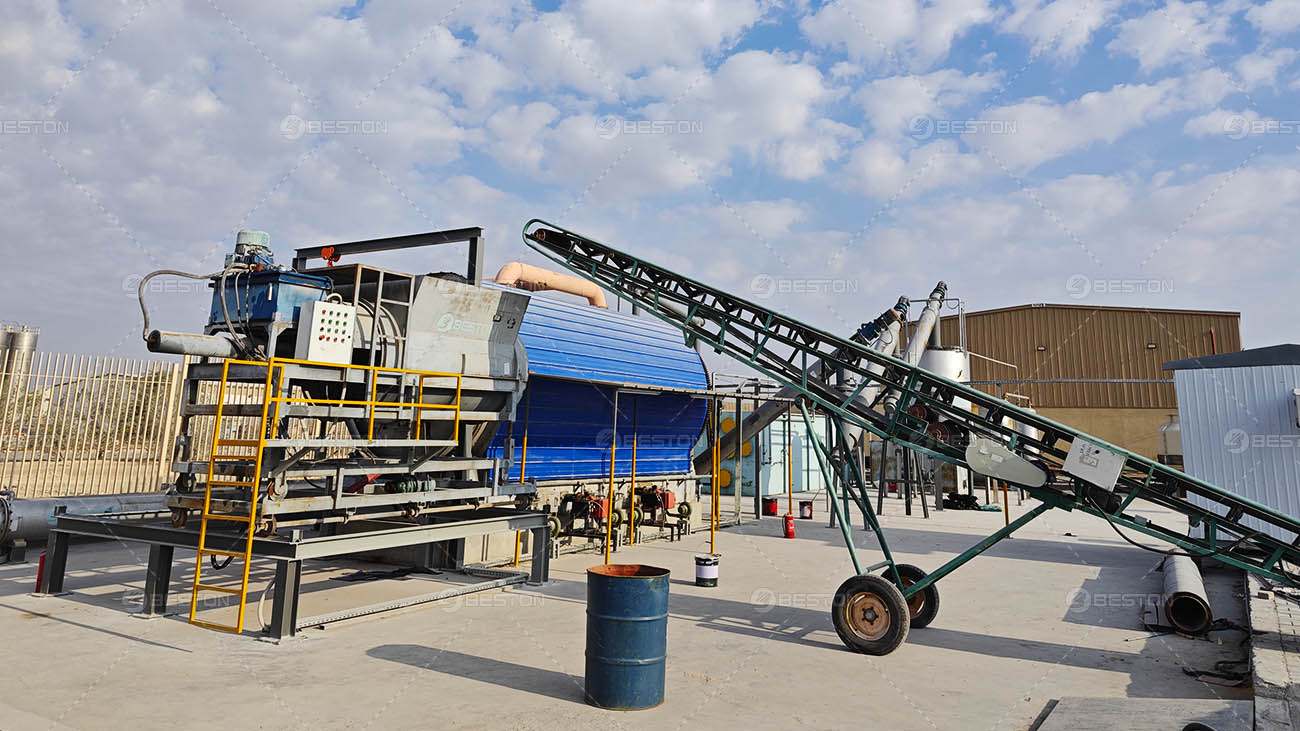The tyre pyrolysis plant represents a significant advancement in waste management technology, focusing on converting used tyres into valuable by-products through pyrolysis. This process involves heating tyres in the absence of oxygen, breaking them down into various components such as pyrolysis oil, carbon black, and steel. Understanding the profit channels associated with a tyre pyrolysis plant is crucial for stakeholders looking to invest in or optimize these systems. This analysis explores the primary revenue streams and considerations affecting the profitability of a tyre pyrolysis plant.

Revenue Streams of a Tyre Pyrolysis Plant
Pyrolysis Oil
Pyrolysis oil is one of the most valuable by-products of the tyre pyrolysis plant. Derived from the thermal decomposition of tyres, this liquid can be refined and used as a fuel or further processed into chemicals and industrial products. The demand for pyrolysis oil in the energy sector, particularly as a substitute for conventional fossil fuels, creates a significant revenue opportunity. Its utilization in diesel engines and as a feedstock in chemical manufacturing enhances its marketability and profitability.
Carbon Black
Another key output of the tyre pyrolysis plant is carbon black, a fine powder produced from the pyrolysis of tyre rubber. Carbon black has extensive applications, including in the manufacturing of tyres, plastics, and inks. Its high value in industrial applications ensures a steady market demand. The quality and type of carbon black produced can influence its price and application, impacting the overall profitability of the plant.
Steel Wire
Tyre pyrolysis plants also recover steel wire from the tyres, which can be sold as scrap metal. Steel recovered from tyres is typically of high quality and can be recycled or sold to metal processing industries. The price of steel wire is subject to fluctuations in global metal markets, but it remains a valuable revenue stream for tyre pyrolysis plants.
By-Product Sales and Utilization
In addition to the primary by-products, tyre pyrolysis plants can generate secondary products that offer further revenue potential. These include:
- Gas: Pyrolysis produces various gases, such as methane and ethylene, which can be used as fuel within the plant to reduce energy costs or sold to external buyers.
- Char: The char, or residual carbon, can be used in various applications, including as a soil amendment or in filtration processes.
Maximizing the utilization of these by-products can significantly enhance the profitability of a tyre pyrolysis plant.
Factors Affecting Profitability
Initial Investment and Tyre Pyrolysis Plant Price
The initial investment required for a tyre pyrolysis plant is a crucial factor influencing profitability. The cost of purchasing and installing a tyre pyrolysis plant can be substantial. Factors such as the size of the reactor, the technology used, and the capacity of the plant all contribute to the overall pyrolysis machine price. Evaluating the return on investment (ROI) involves analyzing the cost of the plant against the expected revenue from the sale of by-products.
Operational Costs
Operational costs play a significant role in determining the profitability of a tyre pyrolysis plant. These include:
- Energy Consumption: Pyrolysis requires significant energy input to maintain high temperatures. Efficient energy management and the use of by-product gases for internal fuel can reduce costs.
- Maintenance: Regular maintenance of the reactor and associated equipment is necessary to ensure smooth operation and longevity. Maintenance costs must be factored into profitability calculations.
- Labour: Skilled labour is required for plant operation, including monitoring and managing the pyrolysis process. Labour costs can impact overall profitability.
Market Prices for By-Products
The profitability of a tyre pyrolysis plant is influenced by the market prices of its by-products. Fluctuations in the prices of pyrolysis oil, carbon black, and steel wire can affect revenue. Keeping abreast of market trends and establishing strong supply chains can help mitigate price volatility and enhance profitability.
Regulatory and Environmental Compliance
Compliance with environmental regulations is essential for the successful operation of a tyre pyrolysis plant. Adhering to regulations regarding emissions, waste disposal, and safety can incur additional costs but is crucial for long-term operation. Ensuring that the plant meets all regulatory requirements can prevent costly fines and operational disruptions.
Technology and Efficiency
The efficiency of the tyre pyrolysis plant is closely related to the technology used. Advanced reactors with higher efficiency can process tyres more effectively, leading to higher yields of valuable by-products. Investing in modern technology and optimizing operational processes can improve overall profitability.
Strategies to Enhance Profitability
Optimizing Reactor Design
The design and configuration of the reactor play a critical role in the efficiency of the pyrolysis process. Implementing advanced pyrolysis reactor technologies that offer higher efficiency and better control over the pyrolysis conditions can increase the yield and quality of by-products. Regularly upgrading and maintaining the reactor ensures optimal performance.
Diversifying By-Product Applications
Expanding the applications of the by-products can open new revenue channels. For example, developing markets for high-quality carbon black in different industries or exploring new uses for pyrolysis oil can increase profitability. Diversification helps mitigate risks associated with fluctuating prices and market demand.

Enhancing Energy Efficiency
Implementing energy-saving measures, such as utilizing by-product gases as fuel or incorporating waste heat recovery systems, can significantly reduce operational costs. Energy efficiency improvements not only lower expenses but also contribute to a more sustainable operation.
Building Strong Supply Chains
Establishing reliable supply chains for raw materials and by-products ensures a steady flow of operations and revenue. Negotiating favorable terms with suppliers and buyers can help stabilize costs and income, contributing to overall profitability.
Continuous Monitoring and Optimization
Regular monitoring and optimization of plant operations are essential for maximizing profitability. Employing data analytics and performance tracking tools can help identify areas for improvement and ensure that the plant operates at peak efficiency. If you want to get intelligent tire recycling equipment, please visit: https://www.bestongroup.com/
Conclusion
The tyre pyrolysis plant offers multiple profit channels through the production and sale of valuable by-products such as pyrolysis oil, carbon black, and steel wire. The overall profitability of the plant is influenced by various factors, including the initial investment, operational costs, market prices, and regulatory compliance. By optimizing reactor design, diversifying by-product applications, and enhancing energy efficiency, stakeholders can improve the financial performance of their tyre pyrolysis operations. Strategic planning and continuous optimization are key to leveraging the full potential of a tyre pyrolysis plant and achieving long-term success in the waste-to-energy industry.